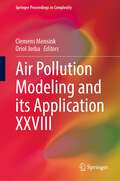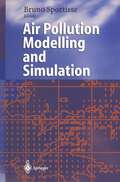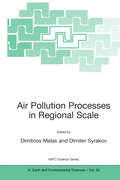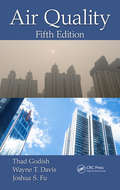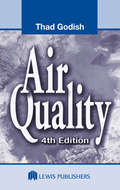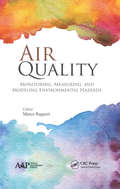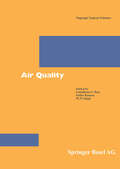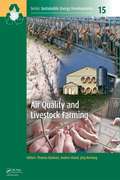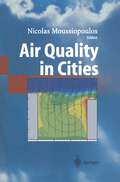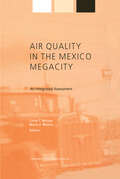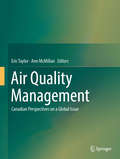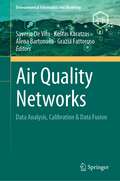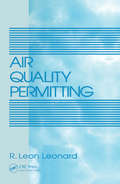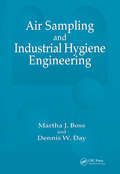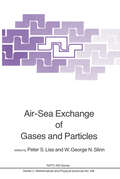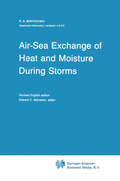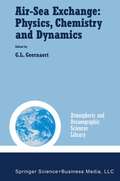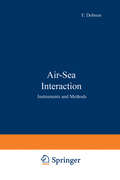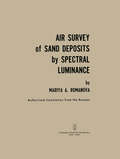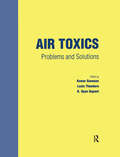- Table View
- List View
Air Pollution Modeling and its Application XXVIII (Springer Proceedings in Complexity)
by Clemens Mensink Oriol JorbaThis book states that current developments in air pollution modeling are explored as a series of contributions from researchers at the forefront of their field. This newest contribution on air pollution modeling and its application is focused on local, urban, regional and intercontinental modeling; long-term modeling and trend analysis; data assimilation and air quality forecasting; model assessment and evaluation; aerosol transformation. Additionally, this work also examines the relationship between air quality and human health and the effects of climate change on air quality.This work is a collection of selected papers presented at the 38th International Technical Meeting on Air Pollution Modeling and its Application, held in Barcelona, Spain, Oct 18–22, 2021. The book is intended as reference material for students and professors interested in air pollution modeling at the graduate level as well as researchers and professionals involved in developing and utilizing air pollution models.
Air Pollution Processes in Regional Scale (NATO Science Series: IV: #30)
by Dimitrios Melas Dimiter SyrakovAn understanding of long-range transport of air pollutants in the atmosphere requires a knowledge of the relevant atmospheric dynamic and chemical processes active at the regional scale as well as the temporal and spatial distribution of emissions. Numerical modeling is the most efficient way to determine the atmospheric transport, photochemistry and deposition pathways. The book therefore discusses the physical and chemical processes that determine regional air pollution and presents the relevant modeling techniques to describe the different atmospheric processes that are active at that scale.
Air Quality
by Thad Godish Wayne T. Davis Joshua S. FuThe fifth edition of a bestseller, Air Quality provides students with a comprehensive overview of air quality, the science that continues to provide a better understanding of atmospheric chemistry and its effects on public health and the environment, and the regulatory and technological management practices employed in achieving air quality goals.
Air Quality
by Thad Godish Joshua S. FuOzone-destroying chemicals, greenhouse gases, and dangerous airborne substances that were once thought to be benign are the most urgent issues facing air pollution control experts. Students need a thorough, updated reference that explores these current trends while also covering the fundamental concepts of this emerging discipline. A new re
Air Quality: Monitoring, Measuring, and Modeling Environmental Hazards
by Marco RagazziThis title includes a number of Open Access chapters. This new compendium provides a nuanced look at monitoring, measuring, and modeling air quality pollution in conjunction with its effects on public health and the environment. Air pollution has been proven to be a major environmental risk to health. Protecting and improving air quality requires knowledge about the types and levels of pollutants being emitted. It also requires the best possible measurement and monitoring capabilities. The chapters in this volume serve as a foundation for monitoring, measuring, and modeling air pollution.
Air Quality: Monitoring, Measuring, and Modeling Environmental Hazards
by Marco RagazziThis title includes a number of Open Access chapters. This new compendium provides a nuanced look at monitoring, measuring, and modeling air quality pollution in conjunction with its effects on public health and the environment. Air pollution has been proven to be a major environmental risk to health. Protecting and improving air quality requires knowledge about the types and levels of pollutants being emitted. It also requires the best possible measurement and monitoring capabilities. The chapters in this volume serve as a foundation for monitoring, measuring, and modeling air pollution.
Air Quality (Pageoph Topical Volumes)
by Gandikota V. Rao Sethu Raman M. P. SinghThis volume, "Air Quality", contains many original findings on biomasss fires, transboundary pollution and associated haze and their impacts on health, biodiversity and economy and thus is expected to be a source book for research in South East Asia. Many of the results presented in this volume pertain to this region and are thus available under one ' roof.' Some papers could be discussed in graduate level classes dealing with Air Pollution, Air Quality, Cloud Physics and Biophysics. The scientific community will find this book a useful addition to their personal and institutional libraries.
Air Quality and Livestock Farming (Sustainable Energy Developments)
by Thomas Banhazi Andres Aland Jörg HartungAir quality has a direct influence on health, welfare and production performance of livestock as the high concentrations of noxious gases, dust and airborne microorganisms are likely to reduce production efficiency and the general welfare of farm animals. Long term exposure to particulates in livestock buildings might also affect the respiratory health of farm workers. Dust in animal buildings contains many biologically active substances such as bacteria, fungi, endotoxins and residues of antibiotics (as a result of veterinary treatments) that are suspected to be hazardous to human health. Furthermore, air pollutants emitted from livestock buildings can reduce air, water and soil quality and can potentially undermine the health of nearby residents. Airborne emissions include ammonia, methane, nitrous oxide, particulates like dust and microorganisms. In addition, other potentially harmful substances such as heavy metals, antibiotic residues and components of disinfectants might be also emitted from livestock building that are potentially damaging to ecosystems. In this book, key aspects of agricultural air quality, such as monitoring, managing and reducing airborne pollutants in and around livestock facilities are reviewed. Features: addressing the raising awareness of the importance of optimal health and welfare for lifestock species with contributions from international specialists and researchers providing up-to-date information for professionals involved in modern animal producti This book will be useful for farming professionals, academics, students, policy makers, business leaders, regulatory bodies and agricultural consultants.
Air Quality and Livestock Farming (Sustainable Energy Developments)
by Thomas Banhazi Andres Aland Jörg HartungAir quality has a direct influence on health, welfare and production performance of livestock as the high concentrations of noxious gases, dust and airborne microorganisms are likely to reduce production efficiency and the general welfare of farm animals. Long term exposure to particulates in livestock buildings might also affect the respiratory health of farm workers. Dust in animal buildings contains many biologically active substances such as bacteria, fungi, endotoxins and residues of antibiotics (as a result of veterinary treatments) that are suspected to be hazardous to human health. Furthermore, air pollutants emitted from livestock buildings can reduce air, water and soil quality and can potentially undermine the health of nearby residents. Airborne emissions include ammonia, methane, nitrous oxide, particulates like dust and microorganisms. In addition, other potentially harmful substances such as heavy metals, antibiotic residues and components of disinfectants might be also emitted from livestock building that are potentially damaging to ecosystems. In this book, key aspects of agricultural air quality, such as monitoring, managing and reducing airborne pollutants in and around livestock facilities are reviewed. Features: addressing the raising awareness of the importance of optimal health and welfare for lifestock species with contributions from international specialists and researchers providing up-to-date information for professionals involved in modern animal producti This book will be useful for farming professionals, academics, students, policy makers, business leaders, regulatory bodies and agricultural consultants.
Air Quality in Cities
by Nicolas MoussiopoulosUrban areas are major sources of air pollution. Pollutant emissions affecting air quality in cities are considered to have adverse consequences for human health. Public and government concern about environmental issues arising from urban air pollution has increased over the last decades. The urban air pollution problem is widespread throughout the world and it is important to find ways of eliminating or at least reducing the risks for human health. The fundamentals of the physical and chemical processes occurring during air pollutant transport in the atmosphere are nowadays understood to a large extent. In particular, modelling of such processes has experienced a remarkable growth in the last decades. Monitoring capabilities have also improved markedly in the most urban areas around the world. However, neither modelling nor monitoring can solve urban air pollution problems, as they are only a first step in improving useful information for future regulations. The defining of efficient control strategies can not be achieved without a clear knowledge of the complete pollution process, i.e. emission, atmospheric transport and transformation, and deposition at the receptor. Improving our ability to establish valid urban scale source-receptor relation ships has been the objective of SA TURN, one of the 14 subprojects of EURO TRAC-2. Similar to the other subprojects of this co-ordinated environmental pro ject within the EUREKA initiative, SA TURN brought together international groups of scientists to work on problems directly related to atmospheric chemistry and physics. The present volume summarises the scientific results of SATURN.
Air Quality in the Mexico Megacity: An Integrated Assessment (Alliance for Global Sustainability Bookseries #2)
by Mario J. Molina Luisa T. MolinaIn this book, experts in atmospheric sciences, human health, economics, social and political sciences contribute to an integrated assessment of the complex elements needed to structure air quality policy in the 21st century. The analysis is developed through a case study of the Mexico City Metropolitan Area - one of the world's largest megacities in which air pollution grew unchecked for decades. The international research team is led by Luisa T. and Mario J. Molina, Nobel Laureate in Chemistry. Improvements in Mexico City's air quality in the last decade testifies to the power of determined and enlightened policy making, and throws into relief the tough problems that remain to be solved.The volume's first six chapters, including the contributions of over 50 distinguished scholars from Mexico and the US, outline the fundamental areas of knowledge policy makers must accommodate. The message is that only good science and well-chosen technologies can direct the way to corrective regulatory measures; but without strong commitment from government, no amount of science or technology can help.
Air Quality Management: Canadian Perspectives on a Global Issue
by Eric Taylor Ann McMillanThis book provides a wide overview of the issues related to managing of air quality in Canada. Learn about the air issues that have caused impacts to ecosystems or human health and hence been targeted to be managed. Discover how Canada’s national governance involving a federal government along with provincial and territorial governments impacts the air quality management process. Understand how Canadians manage their air quality in context with the USA, their largest and closest neighbour. Benefit from the experience of 43 of Canada’s most experienced air quality management professionals who share their insights into the state of air quality in Canada today, how it is managed, as well as giving a glimpse into the future.
Air Quality Networks: Data Analysis, Calibration & Data Fusion (Environmental Informatics and Modeling)
by Saverio De Vito Kostas Karatzas Alena Bartonova Grazia FattorusoThis volume offers expert contributions proposing new and recently set scientific standards for smart air quality (AQ) networks data processing, along with results obtained during field deployments of pervasive and mobile systems. The book is divided into 5 main sections; 1) future air quality networks, 2) general data processing techniques, 3) field deployments performances, 4) special applications, and 5) cooperative and regulatory efforts. The authors offer different sources of data for the production of trustworthy insights, including spatio-temporal predictive AQ maps meant to boost citizen awareness, and informed participation in remediation and prevention policies. Readers will learn about the best and most up-to-date practices for measuring and assessing air quality, while also learning about current regulatory statuses regarding air quality technology design and implementation. The book will be of interest to air quality regulatory agencies, citizen science groups, city authorities, and researchers and students working with air quality sensors and geostatistics.
Air Quality Permitting
by R. Leon LeonardThis practical book covers all of the fundamentals for obtaining air quality permits for new sources of air pollutant emissions and Title V operating permits for operating sources. Written for facility environmental managers, consultants, and air quality regulatory staff, Air Quality Permitting provides a thorough discussion on the strategies of successfully permitting a facility.
Air Quality Permitting
by R. Leon LeonardThis practical book covers all of the fundamentals for obtaining air quality permits for new sources of air pollutant emissions and Title V operating permits for operating sources. Written for facility environmental managers, consultants, and air quality regulatory staff, Air Quality Permitting provides a thorough discussion on the strategies of successfully permitting a facility.
Air Sampling and Industrial Hygiene Engineering
by Martha J. Boss Dennis W. DayWe know certain chemicals cause problems in the workplace. The issues now are: Where do they occur in the workplace? How can we best evaluate them? What are the procedures for dealing with them safely? Many books simply define the problem and tell you that you need a program. Air Sampling and Industrial Hygiene gives you a guide to air sampling protocols from start to finish. The book presents sampling technology updated with today's tools - such as microcircuitry and remote sensing. The authors emphasize an interdisciplinary approach to understanding how air monitoring can adequately report current environmental conditions associated with outdoor media, indoor remediation efforts, proximal equipment, interior line monitoring, and the interrelationship of ventilation parameters. In addition to providing the how-tos of sampling, this guide covers the basics of chemical risk assessment, biological assessment, engineering evaluation of mechanical system design criteria, and chemical or process engineering hazard assessments. It presents the information using text, text outlines, graphics, and pictures - including cross sections of instrumentation and side bars to elaborate on complex concepts.Faulty readings caused by poor sampling techniques can be very costly. This book provides the how-tos for making design engineering and on-site decisions as to instrumentation selection and scheduled usage. Air Sampling and Industrial Hygiene Engineering will allow you to complete the sampling process systematically and correctly from initial suspicions to the use of obtained results.
Air Sampling and Industrial Hygiene Engineering
by Martha J. Boss Dennis W. DayWe know certain chemicals cause problems in the workplace. The issues now are: Where do they occur in the workplace? How can we best evaluate them? What are the procedures for dealing with them safely? Many books simply define the problem and tell you that you need a program. Air Sampling and Industrial Hygiene gives you a guide to air sampling protocols from start to finish. The book presents sampling technology updated with today's tools - such as microcircuitry and remote sensing. The authors emphasize an interdisciplinary approach to understanding how air monitoring can adequately report current environmental conditions associated with outdoor media, indoor remediation efforts, proximal equipment, interior line monitoring, and the interrelationship of ventilation parameters. In addition to providing the how-tos of sampling, this guide covers the basics of chemical risk assessment, biological assessment, engineering evaluation of mechanical system design criteria, and chemical or process engineering hazard assessments. It presents the information using text, text outlines, graphics, and pictures - including cross sections of instrumentation and side bars to elaborate on complex concepts.Faulty readings caused by poor sampling techniques can be very costly. This book provides the how-tos for making design engineering and on-site decisions as to instrumentation selection and scheduled usage. Air Sampling and Industrial Hygiene Engineering will allow you to complete the sampling process systematically and correctly from initial suspicions to the use of obtained results.
Air-Sea Exchange of Gases and Particles (Nato Science Series C: #108)
by P. S. Liss W. G. N. SlinnProceedings of the NATO Advanced Study Institute, Durham, New Hampshire, U.S.A., July 19-30, 1982
Air-Sea Exchange of Heat and Moisture During Storms (Atmospheric and Oceanographic Sciences Library #10)
by R.S. BortkovskiiScientists investigating the interaction between the ocean and the atmosphere now believe that the drag coefficient, and the coefficients of heat transfer and moisture transfer at the sea surface, all increase with an intensification of the wind, reaching high values during a storm. This belief is based on the results of gradient and eddy correlation measurements in the air layer over the water, as weIl as on data concerning the effect of storms on the structure of the upper layer of the ocean and on the planetary atmospheric boundary layer. However, until recently it was impossible to explain just how the above coefficients depend on the wind velocity and to extrapolate this dependence into the region of hurricane velocities. Only by studying nonturbulent mechanisms of transfer, which play an important role dose to the surface of a stormy sea, and mechanisms of spray mediated transfer in particular, was it possible to proceed to a solution of this problem. This book presents the results of laboratory and field studies of the spray field in the air layer above the surface of a stormy sea. Since there is a dose correlation between the generation of spray and the breaking of wind waves, considerable attention is given to the analysis of data on the sea state during a storm. Su'ch data are of interest when solving a number of diverse theoretical and applied problems.
Air-Sea Exchange: Physics, Chemistry and Dynamics (Atmospheric and Oceanographic Sciences Library #20)
by G. L. GeernaertDuring the 1980's a wealth of information was reported from field and laboratory experiments in order to validate andlor modify various aspects of the surface layer Monin-Obukhov (M-O) similarity theory for use over the sea, and to introduce and test new concepts related to high resolution flux magnitudes and variabilities. For example, data from various field experiments conducted on the North Sea, Lake Ontario, and the Atlantic experiments, among others, yielded information on the dependence of the flux coefficients on wave state. In all field projects, the usual criteria for satisfying M-O similarity were applied. The assumptions of stationarity and homogeneity was assumed to be relevant over both small and large scales. In addition, the properties of the outer layer were assumed to be "correlated" with properties of the surface layer. These assumptions generally required that data were averaged for spatial footprints representing scales greater than 25 km (or typically 30 minutes or longer for typical windspeeds). While more and more data became available over the years, and the technology applied was more reliable, robust, and durable, the flux coefficients and other turbulent parameters still exhibited significant unexplained scatter. Since the scatter did not show sufficient reduction over the years to meet customer needs, in spite of improved technology and heavy financial investments, one could only conclude that perhaps the use of similarity theory contained too many simplifications when applied to environments which were more complicated than previously thought.
Air-Sea Interaction: Instruments and Methods
by F. Dobson L. Hasse R. DavisDuring the past decade, man's centuries-old interest in marine me teorology and oceanography has broadened. Ocean and atmosphere are now treated as coupled parts of one system; the resulting interest in air-sea interaction problems has led to a rapid growth in the sophistication of instruments and measurement techniques. This book has been designed as a reference text which describes, albng with the instruments themselves, the accumulated practical experi ence of experts engaged in field observations of air-sea interac tions. It is meant to supplement rather than replace manuals on standard routine observations or instnunentation handbooks. At the inception a textbook was planned, which would contain only well tested methods and instruments. It was quickly discovered that for the book to be useful many devices and techniques would have to be included which are still evolving rapidly. The reader is therefore cautioned to take nothing in these pages for granted. Certainly, every contributor is an expert, but while some are back ed up by generations of published work, others are pioneers. The choice of topics, of course, is debatable. The types of observa tions included are not exhaustive and topics such as marine aero sols and radio-tracers are omitted, as was the general subject of remote sensing, which was felt to be too broad and evol ving too rapidly. The guideline adopted in limiting size was maximum use fulness to 'a trained experimentalist new to the field'.
Air Survey of Sand Deposits by Spectral Luminance
by Mariya A. RomanovaThis book gives an account of a method of determining the type composition of sandy deposits from the air by the nature of their reflection of radiant energy. The measured spectral luminance of a rock outcrop rela ti ve to the luminance of a standard is the basic property considered in this method. The spectral luminance factors p\ are measured by means of special instruments - a universal photometer, cinespectrograph, spectro visors, and other spectrometers. The measured values of P" of the investigated rocks are interpreted geologically with the aid of some methods of mathematical statistics so that a means of lithological mapping of sandy deposits from the air can be found. The importance of developing a method of determining the type composition of rocks, primarily sandy de posits, from the air stems from the extensive occurrence of deserts on the earth's surface. Sandy deserts occupy vast areas in the southern latitudes of the USSR and occur in western and central China, Pakistan, Iran, India, and other states. In these deserts there are numerous deposits of petroleum and gas, and a search for water is continuously in progress. Successful prospecting for the above minerals depends on a determination of the material composition of the sandy deposits in these deserts and the solution of several questions of recent tec tonics, paleogeography, and quaternary geology, the answers to which might also be given by a study of the dis tribution of lithological types of sands.
Air Toxics: Problems and Solutions
by Kumar GanesanThis timely new workbook is the result of a year-long effort by a group of university professors who first met at Montana Tech during the summer of 1994 for a college faculty workshop. The workshop was funded by the National Science Foundation's support for those faculty developing courses in the newly emerging field of air toxics. Part I of the book contains over 100 problems dealing with a variety of topics in this area. Part II provides detailed solutions. The problems and solutions provided will become a useful resource for the training of engineers and scientists who are or soon will be working in the field.
Air Toxics: Problems and Solutions
by Kumar GanesanThis timely new workbook is the result of a year-long effort by a group of university professors who first met at Montana Tech during the summer of 1994 for a college faculty workshop. The workshop was funded by the National Science Foundation's support for those faculty developing courses in the newly emerging field of air toxics. Part I of the book contains over 100 problems dealing with a variety of topics in this area. Part II provides detailed solutions. The problems and solutions provided will become a useful resource for the training of engineers and scientists who are or soon will be working in the field.
